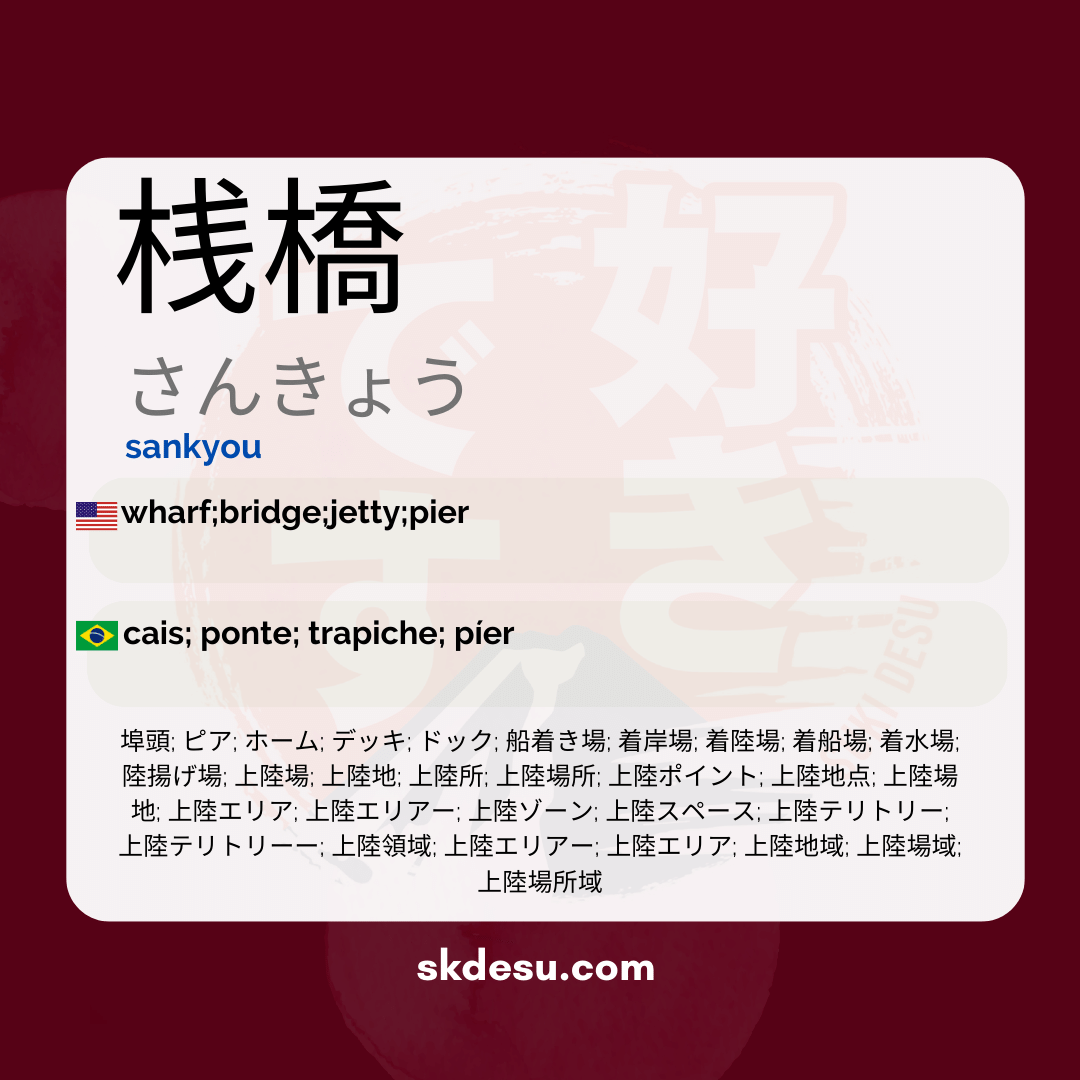Translation and Meaning of: 桟橋 - sankyou
The Japanese word 桟橋 (さんきょう, sankyō) may not be very common in everyday vocabulary, but it has a very specific and interesting meaning. If you have ever visited a port or a coastal area in Japan, you have probably seen a 桟橋 without knowing what it is called. In this article, we will explore the meaning, origin, and use of this word, as well as understand how it appears in Japanese culture and daily life.
If you are learning Japanese or simply curious about the language, understanding terms like 桟橋 can enrich your knowledge. Let's talk about its writing in kanji, practical examples, and even tips to memorize it. All of this in a simple and straightforward way, so you can absorb the content without difficulties.
What does 桟橋 (さんきょう) mean?
The word 桟橋 refers to a structure built over water, usually made of wood or concrete, that serves as a docking place for boats and ships. In English, the closest term would be "dock" or "pier." It is often found in ports, marinas, and even in tourist areas where there are boat rides.
Unlike other similar structures, such as 埠頭 (ふとう, futō), which refers to a larger and more robust quay, 桟橋 is usually simpler and often temporary. Its use is linked both to fishing and maritime transport, being an important part of port infrastructure in Japan.
The origin and the kanjis of 桟橋
The kanji 桟橋 is composed of two characters: 桟 (san) and 橋 (kyō/bashi). The first kanji, 桟, can be associated with support structures or scaffolding, while 橋 means "bridge." Together, they convey the idea of a "mooring bridge" or a structure that extends over water to facilitate access for vessels.
Although the pronunciation さんきょう (sankyō) is the most common, in some regional contexts or in specific combinations, the reading can vary. However, this is a word that rarely appears in other contexts outside of its original meaning, which makes it easier to memorize.
How and when to use 桟橋 in everyday Japanese
As it is a technical term, 桟橋 does not often appear in everyday conversations unless the topic is related to ports, fishing, or navigation. An example of usage would be: 「桟橋で釣りをした」("I fished at the pier"). Sentences like this are more common in coastal areas or in specific contexts.
If you are visiting Japan and want to ask about a place to board a boat tour, you can use 桟橋 in a question such as: 「次の船はどの桟橋から出ますか?」("Which pier does the next boat leave from?"). This type of usage demonstrates how the word is applied in practice.
Curiosities about 桟橋 in Japanese culture
In Japan, many 桟橋 are tourist attractions, especially in coastal cities like Kamakura and Okinawa. They not only serve for docking but also as spots to contemplate the sunset or take photos. Some even appear in Japanese films and dramas, highlighting their cultural significance.
An interesting fact is that during maritime festivals, some 桟橋 are decorated with lanterns or flags, becoming part of the celebration. If you have ever watched scenes from festivals in Japan, you may have seen this structure without realizing its practical function.
Vocabulary
Expand your vocabulary with related words:
Synonyms and similar words
- 埠頭 (Futō) - Pier
- ピア (Pia) - Pier, commonly used for small boats
- ホーム (Hōmu) - Boarding platform
- デッキ (Dekki) - Deck, surface area of a vessel
- ドック (Dokku) - Doc, repair and maintenance shop for boats
- 船着き場 (Funatsukiba) - Boat docking point
- 着岸場 (Chakugansha) - Anchoring location
- 着陸場 (Chakurikuba) - Runway, usually used for airplanes
- 着船場 (Chakusenba) - Docking location for vessels
- 着水場 (Chakusuiba) - Water surface where a vessel touches the liquid
- 陸揚げ場 (Rikuageba) - Unloading location at the port
- 上陸場 (Jōrikuba) - Passenger drop-off area
- 上陸地 (Jōrikuchi) - Disembarkation location, indicating the geographic area
- 上陸所 (Jōrikusho) - Disembarkation point, more formal term.
- 上陸場所 (Jōrikubasho) - Disembarkation point, usually in administrative contexts
- 上陸ポイント (Jōrikupointo) - Specific drop-off point
- 上陸地点 (Jōrikuchiten) - Exact unloading location
- 上陸場地 (Jōrikubaji) - Designated area for disembarkation
- 上陸エリア (Jōrikueria) - Disembarkation area, broader term
- 上陸エリアー (Jōrikueriā) - Disembarkation area variant
- 上陸ゾーン (Jōrikuzōn) - Disembarkation zone, often used in security contexts
- 上陸スペース (Jōrikusupēsu) - Designated area for disembarkation
- 上陸テリトリー (Jōrikuteritorī) - Landing territory, indicating geographic limitations
- 上陸テリトリーー (Jōrikuteritorī) - Variation in use, synonym of landing territory
- 上陸領域 (Jōrikuryōiki) - Disembarkation area, often used in the context of control
- 上陸地域 (Jōrikuchīki) - Disembarkation area, in a broader sense
- 上陸場域 (Jōrikubaiki) - Landing area or space
- 上陸場所域 (Jōrikubashoi) - Restricted disembarkation area
Related words
Romaji: sankyou
Kana: さんきょう
Type: noun
L: jlpt-n1
Translation / Meaning: pier; bridge; warehouse; pier
Meaning in English: wharf;bridge;jetty;pier
Definition: Structure built by the water's edge that serves for mooring and departing of ships and vessels.
Quick Access
- Vocabulary
- Writing
- Sentences
How to Write in Japanese - (桟橋) sankyou
See below a step-by-step guide on how to write the word by hand in Japanese. (桟橋) sankyou:
Example Sentences - (桟橋) sankyou
See below some example sentences:
Sambah de umi wo nagameru no wa totemo subarashii desu
It is wonderful to look at the sea from the pier.
It's great to look at the sea from the pier.
- 桟橋 (sambashi) - a pier, a pier
- から (kara) - from, starting at
- 海 (umi) - the sea
- を (wo) - direct object particle
- 眺める (nagameru) - look, contemplate
- の (no) - particle of possession or explanation
- は (wa) - Topic particle
- とても (totemo) - Very, extremely
- 素晴らしい (subarashii) - Wonderful, excellent
- です (desu) - Verb to be/estar in the present
Other Words of this Type: noun
See other words from our dictionary that are also: noun

